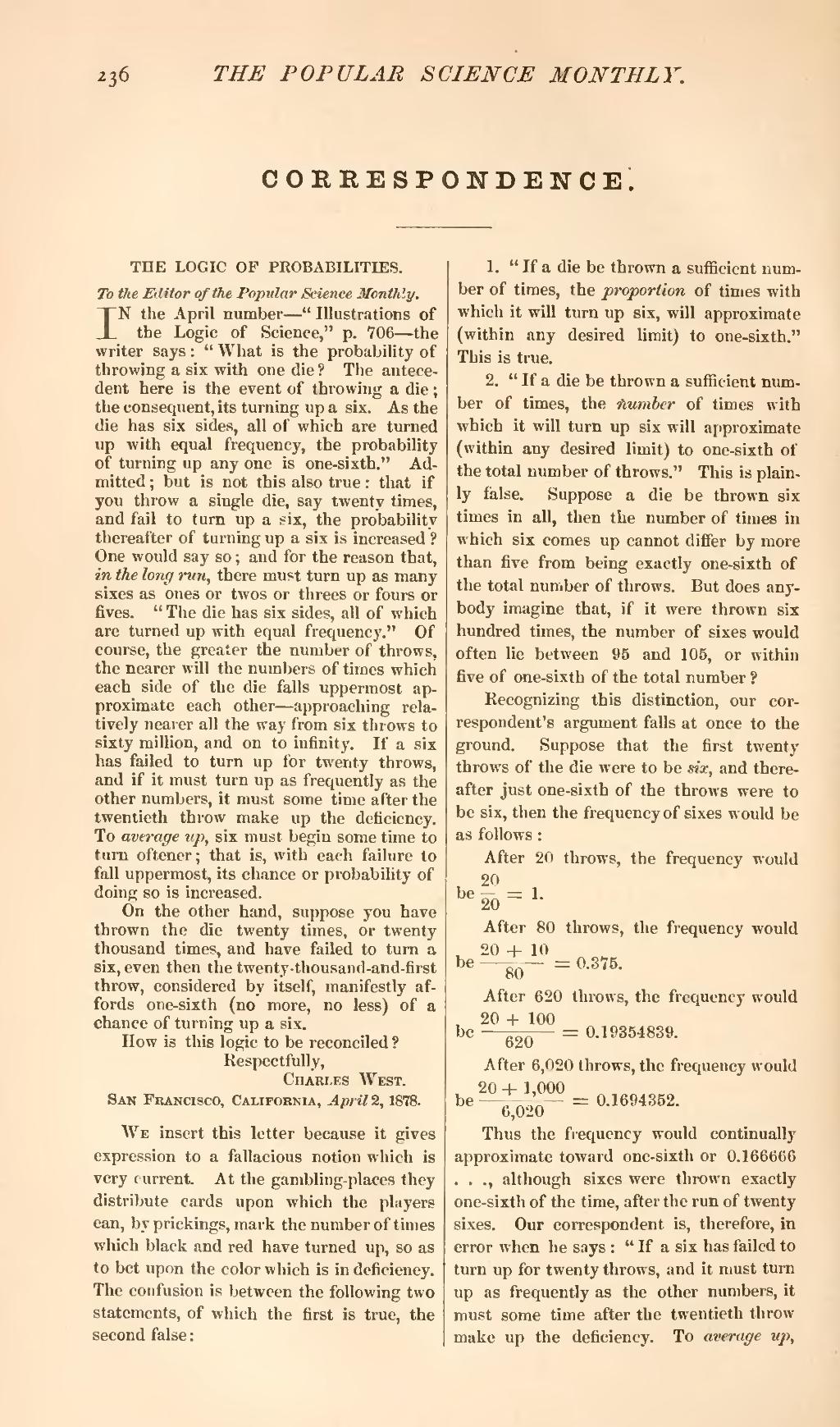THE LOGIC OF PROBABILITIES.
To the Editor of the Popular Science Monthly.
IN the April number—"Illustrations of the Logic of Science," p. 706—the writer says: "What is the probability of throwing a six with one die? The antecedent here is the event of throwing a die; the consequent, its turning up a six. As the die has six sides, all of which are turned up with equal frequency, the probability of turning up any one is one-sixth." Admitted; but is not this also true: that if you throw a single die, say twenty times, and fail to turn up a six, the probability thereafter of turning up a six is increased? One would say so; and for the reason that, in the long run, there must turn up as many sixes as ones or twos or threes or fours or fives. "The die has six sides, all of which are turned up with equal frequency." Of course, the greater the number of throws, the nearer will the numbers of times which each side of the die falls uppermost approximate each other—approaching relatively nearer all the way from six throws to sixty million, and on to infinity. If a six has failed to turn up for twenty throws, and if it must turn up as frequently as the other numbers, it must some time after the twentieth throw make up the deficiency. To average up, six must begin some time to turn oftener; that is, with each failure to fall uppermost, its chance or probability of doing so is increased.
On the other hand, suppose you have thrown the die twenty times, or twenty thousand times, and have failed to turn a six, even then the twenty-thousand-and-first throw, considered by itself, manifestly affords one-sixth (no more, no less) of a chance of turning up a six.
How is this logic to be reconciled?
Respectfully,
Charles West.
San Francisco, California, April 2, 1878.
We insert this letter because it gives expression to a fallacious notion which is very current. At the gambling-places they distribute cards upon which the players can, by prickings, mark the number of times which black and red have turned up, so as to bet upon the color which is in deficiency. The confusion is between the following two statements, of which the first is true, the second false:
1. "If a die be thrown a sufficient number of times, the proportion of times with which it will turn up six, will approximate (within any desired limit) to one-sixth." This is true.
2. "If a die be thrown a sufficient number of times, the number of times with which it will turn up six will approximate (within any desired limit) to one-sixth of the total number of throws." This is plainly false. Suppose a die be thrown six times in all, then the number of times in which six comes up cannot differ by more than five from being exactly one-sixth of the total number of throws. But does anybody imagine that, if it were thrown six hundred times, the number of sixes would often lie between 95 and 105, or within five of one-sixth of the total number?
Recognizing this distinction, our correspondent's argument falls at once to the ground. Suppose that the first twenty throws of the die were to be six, and there-after just one-sixth of the throws were to be six, then the frequency of sixes would be as follows:
After 20 throws, the frequency would be 2020 1
After 80 throws, the frequency would be 20 1080 0.375
After 620 throws, the frequency would be 20 100620 0.19354839.
After 6,020 throws, the frequency would be 20 1,0006,020 0.1694352.
Thus the frequency would continually approximate toward one-sixth or 0.166666 . . . . although sixes were thrown exactly one-sixth of the time, after the run of twenty sixes. Our correspondent is, therefore, in error when he says: "If a six has failed to turn up for twenty throws, and it must turn up as frequently as the other numbers, it must some time after the twentieth throw make up the deficiency. To average up,



